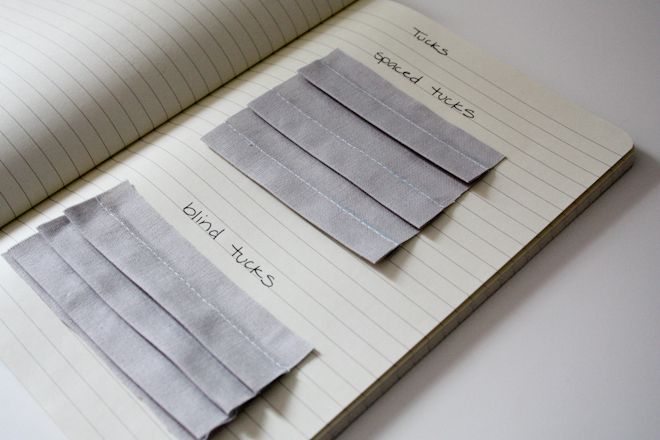Back to: HOME ECONOMICS JSS 2
Welcome to Class !!
We are eager to have you join us !!
In today’s Home Economics class, We will be discussing Tucks. We hope you enjoy the class!

TUCKS
Tucks are small stitches folds in garments. They may be of different widths. The fold is formed on the right side of the garment. They take up three times the finished width of the material. They may be worked on straight grains or in any direction of the material.
Tucks are useful in the following ways:
– For decoration e.g. pin tucks in the front bodice.
– They can be used to introduce shape on a blouse.
– To reduce or control fullness
– To provide extra width

METHODS
- Fold along required line and stitch very close to folds.
- Stitch down to secure a strong finish.
- Turn tucks to the direction desired according to the finished effect required and press.
PLEATS
A pleat is a fold of material designed to give extra width in garments. It is very popular because it is smart and liked by people. It is usually done on medium weight fabrics. Pleats are used mainly on tailored skirts, dress-skirts and shorts giving fullness in wear. There are many kinds of pleats such as the knife pleat, box pleat, inverted pleats and accordion pleats. Pleats are formed by three layers of materials.
Types of pleat
- a) Knife Pleat: One single pleat is called a knife pleat. For knife pleats, the several pleats are facing the same direction. The width of the pleats may be wide or narrow depending on the style.
- b) Box Pleats: This is made when two knife pleats turn away from each other; the folds of the pleats meet on the wrong side.
- c) Inverted Pleats: This is made when two knife pleats turn towards each other and the folds meet on the right side.

METHOD OF WORKING PLEATS
- Working from the right side, fold the material on the fold line. Pin and tack fold separately.
- Place the fold against the next line marked on the right side and pin it down flat.
- Baste (i.e. to sew with long stitches) through the centre of the pleats.
- Press the pleats thoroughly.
EVALUATION
- State three uses of tucks on garments.
- Define darts.
SMOCKING
Smocking is a decorative form of reducing fullness. It provides for elasticity and ease of movement. The allowance of fabric required is usually four times the finished width of smocking. Smocking is very nice on babies’ dresses.

EASING
This is the arrangement of slightly amount of fullness so that no gather or pleat shows where the fullness is set in. Easing is used at the head of a plain sleeve.
GENERAL EVALUATION QUESTIONS
- State three uses of darts.
- List and explain types of darts.
- Explain the process of making gathers
- List and explain types of stitches.
- State five reasons for wearing clothes.
We have come to the end of this class. We do hope you enjoyed the class?
Should you have any further question, feel free to ask in the comment section below and trust us to respond as soon as possible.
We have come to the end of this term and hence JSS2.
It’s been a remarkable journey and we are glad that you have made it this far. For making it this far, we commend you for being resilient, you have taken charge of your education and future.
The Journey still continues though, we are moving on to JSS3. we hope to see there.
